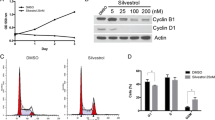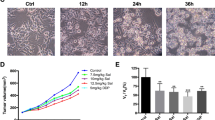Abstract
Melanoma is the most aggressive form of skin cancer and causes 50,000 deaths annually worldwide. The roles of proline-dependent process and autophagy have both been reported in studies on melanoma. In the present study, we focused on the effect of pyrroline-5-carboxylate reductase-2 (PYCR2) on inducing autophagy process in melanoma. The expression of PYCR2 was regulated by an RNAi technique, and the cell proliferation of A375 cell line was determined by methyl thiazolyl tetrazolium test; the effect of PYCR2 on the apoptosis process and AMPK/mTOR pathway was evaluated by flow cytometry assay and Western blot. It was found that silence of PYCR2 resulted in the decrease of proliferative ability and activation of AMPK/mTOR-induced autophagy of A375 cells. PYCR2 silencing also activated AMPK/mTOR pathway in another melanoma cell line, CHL-1. However, the overexpression of PYCR2 seemed to make no difference to the cell viability and targeted pathway. Our results offered a preliminary illustration on the mechanism of the PYCR2-dependent autophagy and showed that PYCR2 was a potential therapeutic target of melanoma.





Similar content being viewed by others
References
Foletto MC, Haas SE. Cutaneous melanoma: new advances in treatment. An Bras Dermatol. 2014;89(2):301–10.
Naser N. Cutaneous melanoma: a 30-year-long epidemiological study conducted in a city in southern Brazil, from 1980–2009. An Bras Dermatol. 2011;86(5):932–41.
Corazzari M, Fimia GM, Lovat P, Piacentini M, editors. Why is autophagy important for melanoma? Molecular mechanisms and therapeutic implications 2013: Elsevier.
Gray-Schopfer V, Wellbrock C, Marais R. Melanoma biology and new targeted therapy. Nature. 2007;445(7130):851–7.
Tsao H, Chin L, Garraway LA, Fisher DE. Melanoma: from mutations to medicine. Genes Dev. 2012;26(11):1131–55.
Rastrelli M, Tropea S, Pigozzo J, Bezzon E, Campana LG, Stramare R, et al. Melanoma m1: diagnosis and therapy. In vivo. 2014;28(3):273–85.
Balch CM, Gershenwald JE, S-j S, Thompson JF, Atkins MB, Byrd DR, et al. Final version of 2009 AJCC melanoma staging and classification. J Clin Oncol. 2009;27(36):6199–206.
Middleton MR, Grob JJ, Aaronson N, Fierlbeck G, Tilgen W, Seiter S, et al. Randomized phase III study of temozolomide versus dacarbazine in the treatment of patients with advanced metastatic malignant melanoma. J Clin Oncol. 2000;18(1):158–66.
Atkins MB, Lotze MT, Dutcher JP, Fisher RI, Weiss G, Margolin K, et al. High-dose recombinant interleukin 2 therapy for patients with metastatic melanoma: analysis of 270 patients treated between 1985 and 1993. J Clin Oncol. 1999;17(7):2105–16.
Roomi MW, Ivanov V, Netke S, Kalinovsky T, Niedzwiecki A, Rath M. In vivo and in vitro antitumor effect of ascorbic acid, lysine, proline and green tea extract on human melanoma cell line A2058. In vivo. 2006;20(1):25–32.
Rath M, Pauling L. Plasmin-induced proteolysis and the role of apoprotein (a), lysine and synthetic lysine analogs. J Orthomolecular Med. 1992;7(1):17–23.
Phang JM, Donald SP, Pandhare J, Liu Y. The metabolism of proline, a stress substrate, modulates carcinogenic pathways. Amino Acids. 2008;35(4):681–90.
Hersey P, Zhang XD. Adaptation to ER stress as a driver of malignancy and resistance to therapy in human melanoma. Pigment Cell & melanoma Res. 2008;21(3):358–67.
Lazova R, Klump V, Pawelek J. Autophagy in cutaneous malignant melanoma. J Cutan Pathol. 2010;37(2):256–68.
Lazova R, Camp RL, Klump V, Siddiqui SF, Amaravadi RK, Pawelek JM. Punctate LC3B expression is a common feature of solid tumors and associated with proliferation, metastasis, and poor outcome. Clin Cancer Res. 2012;18(2):370–9.
Fernández-Barral A, Orgaz JL, Gomez V, Del Peso L, Calzada MJ, Jiménez B. Hypoxia negatively regulates antimetastatic PEDF in melanoma cells by a hypoxia inducible factor-independent, autophagy dependent mechanism. PLoS One. 2012;7(3), e32989.
Lau WS, Chen WF, Chan RYK, Guo DA, Wong MS. Mitogen‐activated protein kinase (MAPK) pathway mediates the oestrogen‐like activities of ginsenoside Rg1 in human breast cancer (MCF‐7) cells. Br J Pharmacol. 2009;156(7):1136–46.
Wu YT, Tan HL, Shui G, Bauvy C, Huang Q, Wenk MR, et al. utophagy via different temporal patterns of inhibition on class I and III phosphoinositide 3-kinase. J Biol Chem. 2010;285(14):10850–61. doi:10.1074/jbc.M109.080796.
De Ingeniis J, Ratnikov B, Richardson AD, Scott DA, Aza-Blanc P, De SK, et al. Functional specialization in proline biosynthesis of melanoma. PLoS One. 2012;7(9), e45190.
Schwartz LM, Smith SW, Jones ME, Osborne BA. Do all programmed cell deaths occur via apoptosis? Proc Natl Acad Sci. 1993;90(3):980–4.
Yorimitsu T, Klionsky DJ. Autophagy: molecular machinery for self-eating. Cell Death Differ. 2005;12:1542–52.
Rubinsztein DC, DiFiglia M, Heintz N, Nixon RA, Qin Z-H, Ravikumar B, et al. Autophagy and its possible roles in nervous system diseases, damage and repair. Autophagy. 2005;1(1):11–22.
Krishnan N, Dickman MB, Becker DF. Proline modulates the intracellular redox environment and protects mammalian cells against oxidative stress. Free Radic Biol Med. 2008;44(4):671–81. doi:10.1016/j.freeradbiomed.2007.10.054.
Zhang L, Alfano JR, Becker DF. Proline metabolism increases katG expression and oxidative stress resistance in Escherichia coli. J Bacteriol. 2015;197(3):431–40. doi:10.1128/JB.02282-14.
Di Stasi D, Vallacchi V, Campi V, Ranzani T, Daniotti M, Chiodini E, et al. DHCR24 gene expression is upregulated in melanoma metastases and associated to resistance to oxidative stress-induced apoptosis. Int J Cancer. 2005;115(2):224–30. doi:10.1002/ijc.20885.
Cotter MA, Thomas J, Cassidy P, Robinette K, Jenkins N, Florell SR, et al. N-acetylcysteine protects melanocytes against oxidative stress/damage and delays onset of ultraviolet-induced melanoma in mice. Clin Cancer Res. 2007;13(19):5952–8.
Alers S, Löffler AS, Wesselborg S, Stork B. Role of AMPK-mTOR-Ulk1/2 in the regulation of autophagy: cross talk, shortcuts, and feedbacks. Mol Cell Biol. 2012;32(1):2–11.
Meley D, Bauvy C, Houben-Weerts JHPM, Dubbelhuis PF, Helmond MTJ, Codogno P, et al. AMP-activated protein kinase and the regulation of autophagic proteolysis. J Biol Chem. 2006;281(46):34870–9.
Miracco C, Cevenini G, Franchi A, Luzi P, Cosci E, Mourmouras V, et al. Beclin 1 and LC3 autophagic gene expression in cutaneous melanocytic lesions. Hum Pathol. 2010;41(4):503–12.
Klionsky DJ, Abdalla FC, Abeliovich H, Abraham RT, Acevedo-Arozena A, Adeli K, et al. Guidelines for the use and interpretation of assays for monitoring autophagy. Autophagy. 2012;8(4):445–544.
Kabeya Y, Mizushima N, Ueno T, Yamamoto A, Kirisako T, Noda T, et al. LC3, a mammalian homologue of yeast Apg8p, is localized in autophagosome membranes after processing. The EMBO journal. 2000;19(21):5720–8.
Mizushima N, Yoshimori T. How to interpret LC3 immunoblotting. Autophagy. 2007;3(6):542–5.
Jung CH, Ro S-H, Cao J, Otto NM, Kim D-H. mTOR regulation of autophagy. FEBS Lett. 2010;584(7):1287–95.
Mizushima N. Methods for monitoring autophagy. Int J Biochem Cell Biol. 2004;36(12):2491–502.
Kahn BB, Alquier T, Carling D, Hardie DG. AMP-activated protein kinase: ancient energy gauge provides clues to modern understanding of metabolism. Cell Metab. 2005;1(1):15–25.
Acknowledgments
This work was supported by grants from the National Natural Science Foundation of China (No. 81272987, 81373075, 81371748).
Author information
Authors and Affiliations
Corresponding authors
Additional information
Rongying Ou and Xueqi Zhang contributed equally to this work.
Rights and permissions
About this article
Cite this article
Ou, R., Zhang, X., Cai, J. et al. Downregulation of pyrroline-5-carboxylate reductase-2 induces the autophagy of melanoma cells via AMPK/mTOR pathway. Tumor Biol. 37, 6485–6491 (2016). https://doi.org/10.1007/s13277-015-3927-8
Received:
Accepted:
Published:
Issue Date:
DOI: https://doi.org/10.1007/s13277-015-3927-8




